Meteorites are rocky or metallic bodies from space that survive passage through Earth's atmosphere and reach the surface. They often originate from asteroids or comets, with some from the Moon or Mars. Meteorites represent some of the original materials that formed planets billions of years ago, providing insights into the early Solar System. Most come from the asteroid belt between Mars and Jupiter, formed from asteroid breakups early in Solar System history. Some rare ones are from Mars or the Moon, ejected by impacts.

1. Stony: The most common, including chondrites (with small spheres called chondrules, primitive and containing pre-solar grains) and achondrites (differentiated, similar to igneous rocks).
2. Iron: Composed mainly of iron and nickel, often from the cores of asteroids, with subgroups like octahedrites and hexahedrites based on crystal structure.
3. Stony-Iron: A mix of stone and metal, such as pallasites (olivine crystals in metal) and mesosiderites (breccias of metal and silicate). Meteorites are classified by mineralogical, petrological, chemical, and isotopic properties.

The largest known intact meteorite on Earth, located in Namibia, weighing about 60 tons. Discovered in 1920 by farmer Jacobus Hermanus Brits while plowing his field, it fell less than 80,000 years ago and has never been moved due to its size. It is an iron meteorite (ataxite type) composed of 84% iron, 16% nickel, and traces of cobalt. Hoba is twice as massive as the largest fragment of the Cape York meteorite and is a national monument in Namibia.

The largest carbonaceous chondrite ever found, fell in Mexico on February 8, 1969, as a fireball witnessed at 01:05. It scattered over 50 square kilometers and is often called the best-studied meteorite. Contains microscopic diamonds with unusual isotopic signatures from supernovas, pre-solar grains, and organic compounds. Its composition matches the Sun's, aiding in understanding Solar System formation. Allende has large white inclusions and chondrules in a dark matrix.

A superbolide that entered Earth's atmosphere over Russia on February 15, 2013, at 09:20 YEKT, exploding 14 miles above ground with energy equivalent to 500 kilotons of TNT. The asteroid was about 20 meters in diameter, causing a shockwave that damaged over 7,000 buildings and injured over 1,000 people, mostly from broken glass. It is an ordinary chondrite (LL5 type) and the most spectacular cosmic event in recent decades, highlighting planetary defense needs.

A carbonaceous chondrite that fell in Australia on September 28, 1969, with over 100 kg recovered. Rich in organic compounds, including over 1,000 molecular species like amino acids, sugars, and nucleic acid bases, making it key for studying origins of life. Contains pre-solar grains like nano-diamonds and silicon carbides from supernovas, older than the Sun. Its soluble organics vary from small molecules to complex polymers.

A Martian meteorite discovered in Antarctica in 1984, ejected from Mars about 16 million years ago and landed on Earth 13,000 years ago. It sparked controversy in 1996 when NASA claimed evidence of ancient microbial life, including bacteria-shaped objects and magnetite crystals possibly biogenic. However, debates continue as some argue these could form inorganically. ALH84001 is an orthopyroxenite, about 4.1 billion years old, and remains a key sample for Mars studies.
